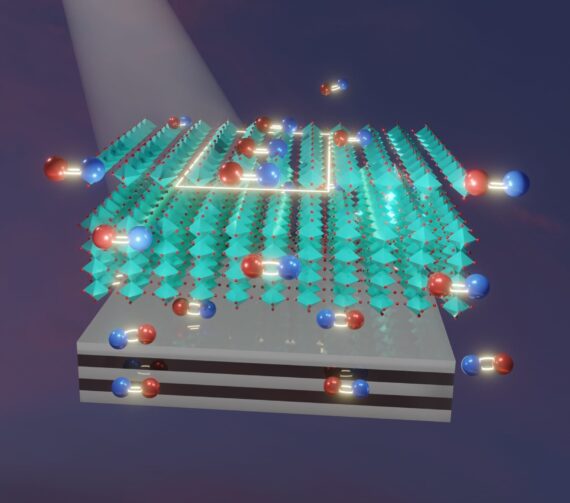|
|
|
|
 This illustration from the lab of Chunlei Guo shows the interaction between a perovskite material (cyan) and a substrate of metal-dielectric material. The red and blue pairings are electron-hole pairs. Mirror images reflected from the substrate reduce the ability of excited electrons in the perovskite to recombine with their atomic cores, increasing the efficiency of the perovskite to harvest solar light. (Graphic by Chloe Zhang)
Perovskites just got a lot more efficientPerovskites—a family of materials nicknamed for their crystalline structure—have shown extraordinary promise in recent years as a far less expensive, equally efficient replacement for silicon in solar cells and detectors. Now, a study led by Chunlei Guo, a professor of optics, demonstrates a novel, physics-based approach to bringing that promise closer to actual applications. The findings are reported in Nature Photonics.
Researchers typically synthesize perovskites in a wet lab, and then apply the material as a film on a glass substrate to explore various applications.
Guo’s lab instead uses a substrate of either a layer of metal or alternating layers of metal and dielectric material—rather than glass—increasing the perovskite’s light conversion efficiency by 250 percent. Learn more.
Apply for Undergrad Research Expo, Discover GrantsThe Undergraduate Research Expo application window is now open. Students looking to present their research in a fun, University-wide setting are encouraged to apply.
Submissions from students of all disciplines are welcome and are due March 15. All research done at Rochester, at another institution, over the summer, or during the academic year is welcome at the expo, which takes place Friday, April 14. All students, faculty, staff, family, and friends are welcome to attend.
The Schwartz Discover Grant application for summer research funding is also open. Current undergraduate students who will be returning in the fall semester, and are planning to do unpaid research this summer under a University supervisor, may apply for the Schwartz Discover Grant for summer undergraduate research funding of up to $5,000. The application deadline is March 31.
Contact the Office of Undergraduate Research with questions.
How fruit flies and roundworms transform neuroscience
University researchers are using nematodes (shown in background) and fruit flies to better understand the mechanisms that regulate brain structure, function, and aging.
Fruit flies (Drosophila) and roundworms (C. elegans) might seem creepy and crawly, but they help Medical Center neuroscientists better understand the mechanisms that regulate brain structure, function, and aging.
“The fact that the C. elegans’ neuroanatomy is simple is one of the original reasons it was chosen as a model system,” explains Douglas Portman, professor of biomedical genetics, neuroscience, and biology. “But C. elegans does have relatively complex behaviors.” As a result, University researchers:
- Have discovered that male brains—at least in C. elegans—will suppress the ability to locate food to focus on finding a mate.
- Are able to leverage the molecular underpinnings of Alzheimer’s together with recent genome-editing technologies such as CRISPR/Cas9 to define the precise mechanism through which toxic tau compromises mitochondrial function and accelerates neuronal aging.
“Drosophila have very complex behaviors, similar to larger animals. Flies are trainable in a Pavlovian behavior,” says Matthew Rand, associate professor of environmental medicine. “For example, you can train a fruit fly to go towards a light based on a reward of food being there. Some fundamental neurobiological circuits and processes are coded in this tiny little organism.” In light of this, University researchers:
- Discovered that the developing muscular system is a sensitive target to methyl mercury along with the nervous system.
- Aim to understand the gene involvement in Parkinsonism—a group of neurological disorders that cause movement problems similar to those seen in Parkinson’s disease and neurodegeneration.
- Understand how the brain encodes feeding experiences and how it uses those experiences to inform memory formation and make future feeding decisions.
Learn more.
Neurons that ‘learn’ to smell a threatWhether conscious of it or not, when entering a new space, we use our sense of smell to assess whether it is safe or a threat. In fact, for much of the animal kingdom, this ability is necessary for survival and reproduction. Researchers at the Del Monte Institute for Neuroscience are finding new clues to how the olfactory sensory system aids in threat assessment and have found neurons that “learn” if a smell is a threat.
“We are trying to understand how animals interact with smell and how that influences their behavior in threatening social and non-social contexts,” says Julian Meeks, principal investigator of the Chemosensation and Social Learning Laboratory. “Our recent research gives us valuable tools to use in our future work and connects specific sets of neurons in our olfactory system to the memory of threatening smells.”
In mice, researchers have identified a specific set of neurons in the accessory olfactory system that can learn the scent of another mouse that is a potential threat. The findings are described in a paper recently published in The Journal of Neuroscience.
Learn more.
Research funding for innovative health tools, methods, approachesThe University of Rochester Clinical and Translational Science Institute’s Digital Health Seedling Award provides up to $25,000 to support research that advances the development, approval, adoption, and use of innovative digital health tools, methods, and approaches.
The one-year award is available to full-time faculty at the University of Rochester who are studying digital health approaches, tools, and data including utilizing sensors and mobile technologies, electronic medical records, data from registries, and other real-world data and approaches to advance clinical research and address regulatory science needs.
Apply by Monday, March 27, 2023.
|
|
|
|
|